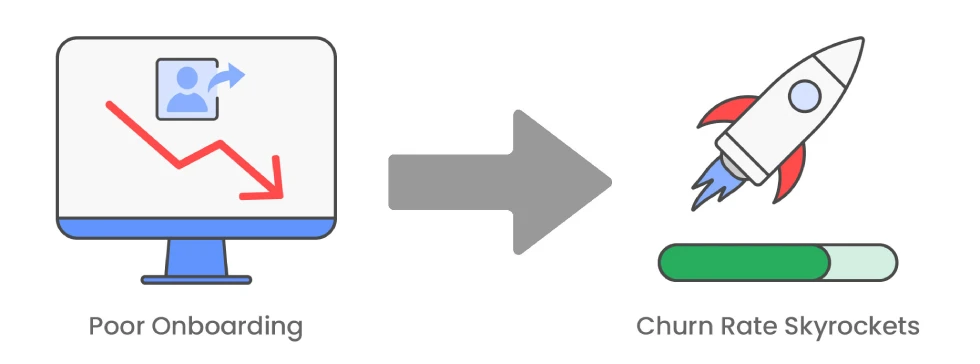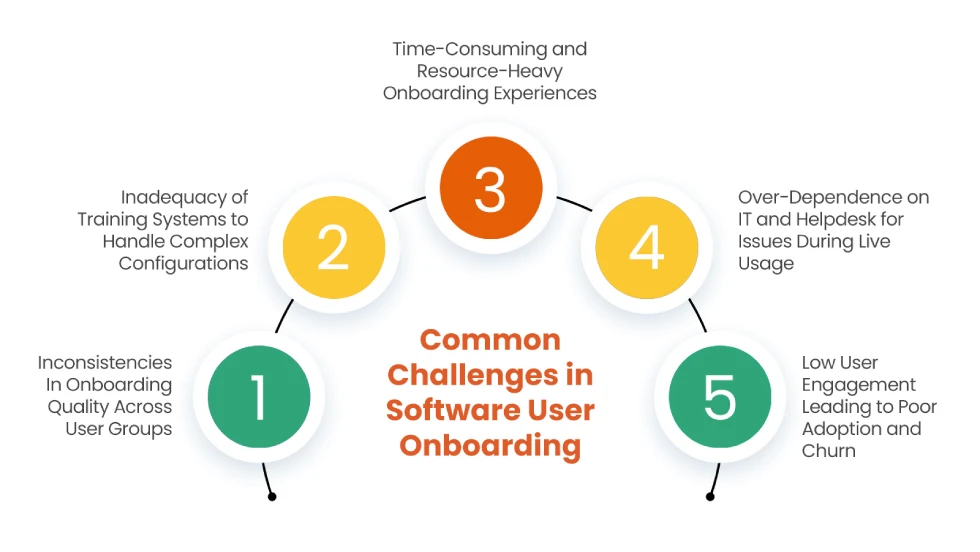Introduction
Did you know that as much as 63% of SaaS customers consider their onboarding experience as a crucial factor in deciding whether to avail of the offerings of a software company. Moreover, a poor onboarding experience is the third biggest cause for customer churn for enterprises, including software companies. These stats prove how essential it is for software companies to nail their customer onboarding process. Customer demos, static videos, and user manuals are no longer feasible – the first is not very scalable, while the second and third are not interactive and uncustomizable to customer requirements. If the software you sell has a steep learning curve, these outdated resources would be insufficient to capture the true essence and value of the software.

The option with the most pay-off would be to utilize solutions that provide digital adoption for user onboarding. You might think that digital adoption platforms are only for enterprise software training for employees of a company. However, that could not be further from the truth. Any organization looking to onboard end-users of new software at scale can use this option. This includes product onboarding for software companies, for which you need a solution that allows you to easily personalize onboarding experiences for hundreds of customers in a sustainable manner. In short, you need a solution like Assima.
Here’s what Assima can do for software companies that need a scalable and customizable onboarding solution.
The Importance of Scalable User Onboarding
As we explained above, research shows how deeply the onboarding experience impacts customer retention and product satisfaction. Any experienced executive and salesperson knows how much more costly new customer acquisition is than retention. This automatically suggests that if you can retain your customers for a long time, the ROI you report will automatically be higher. And retention rates can be raised significantly simply by onboarding new users effectively.
However, traditional methods like manual training, customer demos, webinars, and SOPs are no longer capable of handling complex software solutions or the higher expectations of digitally aware customers. They are also unable to find the right balance between scalability and personalization. In this age of digital localization, both these factors are a must in catering to customers across the world without making the mistake of utilizing a one-size-fits-all approach.
Common Challenges in Software User Onboarding
Software Providers commonly face certain challenges when onboarding software users which we have explained below:
Inconsistencies In Onboarding Quality Across User Groups
The most common onboarding techniques used previously by software vendors were in-person demos and live support. These methods are highly reliant on the trainer or customer service executive assigned to the customer. It diminishes the objectivity and quality consistency of onboarding across user groups.
Inadequacy of Training Systems to Handle Complex Configurations
Some software providers use LMSs or very simple platforms for digital adoption for user onboarding. These learning systems are not equipped to handle the complexity of software configurations for different user bases, and neither are they able to provide content externally for all customers, while tracking usage and completion.
Time-Consuming and Resource-Heavy Onboarding Experiences
Any personnel-dependent onboarding method is bound to consume a significant amount of time and resources since the customer experience must be crafted from scratch every time. This not only reduces the number of sales you can make in a period but also severely eats into the ROI and profit you project for every sale.
Over-Dependence on IT and Helpdesk for Issues During Live Usage
Poor onboarding experiences lead to inadequate understanding of the product by the customer. This not only leads to less-than-ideal levels of efficiency in software usage but also increases errors and doubts post-onboarding. The IT and customer helpdesk teams at your company get tied up solving these rather than more important issues.
Low User Engagement Leading to Poor Adoption and Churn
Poor onboarding translates to low adoption and engagement among customers. This can give rise to one of two situations, both resulting in the same outcome. Either the customer will outright return the product as they fail to see its value, or they will labor through the initial days and reject the prospect of renewal, resulting in churn.

How Digital Adoption Platforms Enable Scalable Onboarding
In today’s fast-paced digital landscape, ensuring a seamless onboarding experience for your customers is crucial. Leveraging dedicated platforms in the process of digital adoption for user onboarding is the most scalable, feasible, and reliable way to ensure fruitful onboarding experiences for your customers, and here’s how:
Hands-On Learning
Software onboarding solutions provide an immersive, hands-on learning experience that promotes knowledge retention and application skills. By living through the process during learning, memory is bolstered, and recall is enhanced during live usage on the actual system.
Self-Paced Guidance
Most DAPs allow users to learn at their own pace, thus avoiding the pitfalls of either moving too quickly and resulting in poor understanding or proceeding too slowly and becoming bored and disengaged. This reduces the learning curve and creates motivated learners and users.
Personalization
DAPs are usually designed to allow a high level of customizability based on user roles and responsibilities, regions in terms of languages, cultural nuances, and legal differences, as well as usage preferences and needs, to improve efficiency and productivity.
Embedded Support
Most onboarding tools for software providers include some form of embedded support that provides real-time, round-the-clock guidance to users on the live system. Some solutions take it further by detecting the role and task for contextual information provision.
Progress tracking
It is important for software providers to know how well their customers are faring during the onboarding phase so that they can provide targeted support and refine their learning path. This is where progress tracking and data analytics aids software companies.
Learn in detail about what a digital adoption platform is and what it can do for you.
Why Assima Train is Built for Software Providers
Assima is one of the most ideal software onboarding solutions, specifically designed to aid software companies in onboarding new customers in using their products while familiarizing existing customers with updated versions. Here’s why:
Simulation-Based Training
Assima Train user onboarding is based on hyper-realistic, interactive simulations that provide a safer environment for scenario-based training than live training. Customers can practice core workflows and exact system processes as many times as they want without impacting live systems.
In-App Support
Assima In-App Search encourages just-in-time learning with contextual in-app guidance for onboarding at the exact point of need, reducing errors and enhancing user experience. Moreover, your helpdesk team is relieved from solving minor issues while your customers feel more empowered.
Multilingual Onboarding
With cloud support becoming a staple for software providers, multilingual onboarding is a necessity for catering to a global customer base. Assima has built-in translation, localization, and centralized cloud capabilities that allow you to scale onboarding to users anywhere in the world with ease.
Easy Cloning and Editing
Assima’s 4X patented, object-based cloning technology allows you to make granular modifications to its simulations. Hence, you can edit your lessons and produce multiple copies without re-recording, making it possible to feasibly train users in software updates before the actual update rolls out.
Seamless Integration
Assima is highly compatible with all kinds of software, including homegrown and legacy software, making it perfect for software companies. Being system and application-agnostic, Assima can create simulations for any application by directly scanning its code, without affecting the live environment.
Detailed Analytics
Assima has a centralized analytics dashboard that provides detailed reports, actionable insights, and live data regarding the learning and usage data of every user. This helps software providers amend learning paths to make them more effective and even receive feedback regarding their product UX.
Best Practices for User Onboarding at Scale
With the right platform and the best practices, you can optimize digital adoption for user onboarding without any hurdles. Follow these tips for the best results:
- Conduct thorough research to ensure your offering aligns with customer needs.
- Begin onboarding during the trial or demo phase itself to prevent adoption delays.
- Conduct thorough user acceptance testing for highly custom configurations requested by customers.
- Segment onboarding by persona, industry, product tier, and any other applicable differentiation.
- Continuously optimize onboarding paths based on user feedback and usage data for an optimum experience.
- Ensure onboarding is localized, culturally appropriate, and legally compliant to prevent issues down the line.
- Keep the channel open for free communication even after training, so customers feel supported throughout the usage lifecycle.
- When choosing DAPs for onboarding, ensure that the solution being assessed meets all your business and customer needs.
Conclusion
DAPs are built to enhance the learning experience when training to use new software. This extends to the customers of software companies too. The strategic advantage of using a DAP lies in getting a packaged solution built expressly for the purpose of onboarding – you no longer need to recreate the onboarding experience from scratch, based on trial and error, hoping for the expected results. Especially with Assima, you will have every functionality at your disposal that you need to build the perfect learning experience when onboarding users. We make your life as well as your customers’ lives easier.
Get a solution tailored for your software company and product by discussing your needs with our experts.
Frequently Asked Questions
Let’s Answer Some of Your Questions.
A digital adoption platform is a software solution built to help end-users learn how to use any application and adopt it to its fullest potential. It provides an optimum training and onboarding experience for any software to any type of user.
Most software providers either opt for techniques with low scalability and sustainability like live demos, or static methods like user manuals for onboarding. However, in today’s age, you need scalable as well as interactive learning tools for an optimum onboarding experience.
Assima Train offers hands-on, immersive onboarding using simulations to improve knowledge retention and enhance learner engagement. Its subsidiary tool, In-App Search, also provides real-time support in the live application. Combined, they provide an optimum experience for user onboarding.
Multiple factors play a role in making onboarding successful on a scale. Multilingual learning, cultural sensitivity, legal compliance, cloud capabilities, centralized learning management, and comprehensive analytics are all essential requirements.
Assima Train simulations provide hands-on learning in a safe environment, while In-App Search provides just-in-time, in-app support. Together, they have been proven to reduce the generation of support tickets from users.